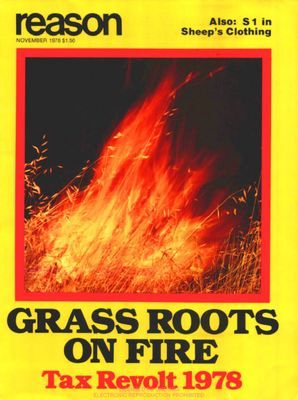Prop. 13 Split Roll Would Be Ripoff
by CalWatchdog Staff | June 20, 2011 8:53 am
 [1]JUNE 20, 2011
[1]JUNE 20, 2011
By WAYNE LUSVARDI and CHARLES B. WARREN
Democrats in the California Legislature want to repeal the property tax reassessment protections of Proposition 13[2] for commercial properties under the dubious notion that there is a pot of California 49er gold at the end of the rainbow. Prop. 13’s existing protections for homeowners would remain the same.
If the commercial protections are removed, this would create what’s called a “split roll”: different tax rates would apply to home and commercial property.
The vehicle being used to create split roll is AB 448[3]. But Democrats, to twist a phrase from Mark Twain when he was in California, may find that “there’s no gold in them thar hills.”
The current system of property taxation in California under Prop. 13 is based on reassessing all properties in the state only when there is a valid sales transaction, just as capital gains taxes are paid only when stock is sold.
Under AB 448, all 494,693 commercial properties in the state would be reassessed annually, while residential properties would still be reassessed only upon resale. It is uncertain if the existing 1 percent base tax rate and 2 percent annual maximum inflation adjustment under Prop. 13 would stay the same.
Proponents of increased taxation as a solution to California’s structural budget deficit have clamored for years for adoption of a more “equitable” split commercial-residential property roll tax. They say it would raise the assessed value of all non-residential property to the property’s market value. To such taxation advocates, “rich” commercial property owners are being granted an unfair subsidy that is robbing public schools and the medically needy.
However, the recent real estate market crash has seen commercial property values falling to levels that now are generally at the same level with assessed value ratios.
The problem with the proposal currently being floated about the state legislature is that no one seems to have done some simple arithmetic.
In 2008 economists William Hamm and Jose Alberro completed a study, “The Economic Effects of Adopting a Split Roll Property Tax.”[4] It concluded that, as of 2007, commercial properties were assessed at 60 percent of their market value and residential properties at about 53 percent of market value.
We asked Co-Star Real Estate Market Data service to trend commercial real estate values in California from 2007, which was near the peak of the Real Estate Bubble, and coincident with the market data that Hamm and Alberro relied on in their study.
35 Percent Commercial Property Decline
The results of Co-Star’s analysis of 11,145 sold properties indicate that average unit values for all commercial properties have declined about 35 percent from 2007 to the end of 2010. This is generally consistent with other national commercial property value indexes, such as Moody’s Commercial Property Index.
Co-Star reported that the average unit price of all sold commercial properties dropped from about $185 in 2007 to $117 per square foot (36 percent) by the end of 2010. Smaller owner-user properties declined from $142 to $100 per square foot (30 percent).
California Commercial Property Unit Price Trend
| Year | Price Per Sq. Ft. |
| 2007 | $184.48 |
| 2008 | $175.16 |
| 2009 | $123.10 |
| 2010 | $117.25 |
| Source: Co-Star Real Estate Data. Data reflects sold commercial properties 10,000 to 100,000 sq. ft. in size from 2007 to end of 2010. | |
.
If commercial property values have declined about 35 percent since 2007, their market value today would be about 65 percent of the value at that time.
We additionally contacted the California State Board of Equalization for the commercial property tax assessment ratio they used for the years 2006 to 2010, which were:
2006 — 65.6 percent
2007 — 61.0 percent
2008 — 59.9 percent
2009 — 58.0 percent
2010 — 65.1 percent
Change in Commercial Market Values and Assessment Ratios
| 2007 | Percent Change | End of 2010 | |
| Market Value | 100 percent | -35 percent | 65 percent |
| Assessed Value Ratio | 65 percent | 0 percent | 65 percent |
| Added Revenue Potential | 35 percent | 0 percent | |
| Source: California Board of Equalization; Co-Star Real Estate Data | |||
.
Split-Roll: No New Revenues
Thus, extinguishing Prop. 13 reassessment protections for commercial properties would be a non-starter. It would not yield any large increase in tax revenue, as shown in the table above. It would be another California Gold Rush, but for fool’s gold.
From 1850 to 2011, California has gone from “gold country” to “tax country.” The Party of Government in California is like the opposite of Rumpelstiltskin — they know how to turn gold into straw.
Perhaps poet John Greenleaf Whittier, one of the early founders of the Republican Party, said it best:
Give fools their gold, and knaves their power;
let fortune’s bubbles rise and fall;
who sows a field, or trains a flower,
or plants a tree, is more than all.
Note: This is the first in a series of stories on California’s proposal to eliminate the protections of Proposition 13 for commercial properties. We won’t be responding to comments until subsequent articles are also posted expanding and clarifying the above. However, please leave comments.
Next: Part 2 – “Dunning Commercial Prop 13 is King Midas in Reverse.”
Wayne Lusvardi is former chief appraiser for a large water district in Southern California and writer at Calwatchdog.com[5]. Charles B. Warren, ASA, MRICS (Urban-Real Property), is a former county assessor and currently an appraiser in San Francisco.
- [Image]: http://www.calwatchdog.com/wp-content/uploads/2011/06/Prop.-13-Reason-mag-grass-roots-on-fire.jpg
- Proposition 13: http://ballotpedia.org/wiki/index.php/California_Proposition_13_%281978%29
- AB 448: http://totalcapitol.com/?bill_id=201120120AB448
- “The Economic Effects of Adopting a Split Roll Property Tax.”: http://www.cbpa.com/documents/split_roll_final_report.pdf
- Calwatchdog.com: http://calwatchdog.com/
Source URL: https://calwatchdog.com/2011/06/20/prop-13-split-roll-would-be-ripoff/